Bennett Clark undertook both portraiture, commercial work, the
production of postcards - and anything else that came along.
| This is a half plate print, giving three gentlemen
the full, traditional and pompous treatment. One would
love to know who they are - and are they father and two sons? Bennett Clark could adapt his style to whatever was fashionable
or whatever the client wanted. |
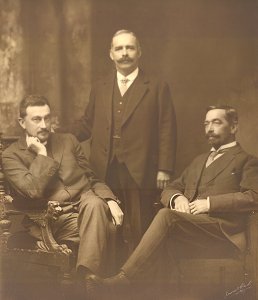 |
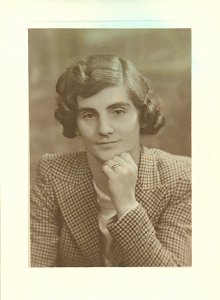 |
This photo, neatly presented in a dark buff
folder, would be typical of his studio work. Anyone who
wanted to, from high to low, could come to his studio. |
But, of course, when it came to the very highest, the
photographer went to the client. In July 1900, when King George V
and Queen Mary (then the Duke and Duchess of York) visited the Mander
family at Wightwick Manor, there was only one photographer suitable to
record the occasion. Bennett Clark took the photos. Theodore Mander was the Mayor at the time. The royal couple visited the
Orphanage and the Duke unveiled the foundation stone of the Library.
They planted trees at Wightwick (a purple-twigged lime by the Duke and a
copper beech by the Duchess - now looking magnificent at the end of the
south terrace garden) and then had a formal photo taken in front of the
house. Fifty years later, in 1950, Sir Geoffrey sent Queen Mary cuttings
from the trees along with copies of the official photos from 1900
and a list of the people shown on the photos. Presumably the copies were
taken by Bennett-Clark.
| The reply from Queen Mary's Private Secretary (of
which there is a copy on show at Wightwick) states how Queen
Mary remembered the day well and could recollect all of the
people on the photo without the aid of Sir Geoffrey's list!
Sir Geoffrey, duly sent this letter to Bennett Clark.
"The enclosed" is probably a cheque for Clark's charges for
providing copies.
(Thanks to David Bennett for information on this event). |
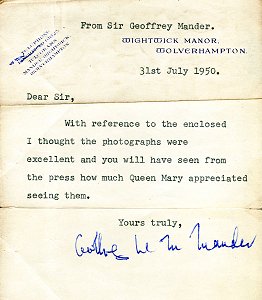 |
Not surprisingly this letter was also carefully
preserved and came in the cache of photos from Hart.
Such a commission was, of course, unusual. Some
examples of Clark's earlier and more usual bread and butter work are
shown below.
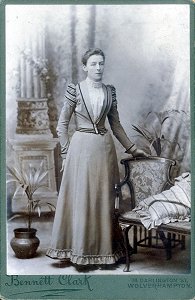 |
This is a turn of the century cabinet size studio photo.
The column and curtains at the back are a painted backcloth. The
potted plants and the sofa are Clark's studio props.
The studio and the pose are pretty standard but the technical
quality of the photo is very high. In the original the details
of the white lace collar are clear - many photographers would only
have got a white blur. |
| A typical late Victorian carte de visite.
There is nothing remarkable about the standard, formal pose. Indeed anything other than the usual pose would have been
objected to by most clients. But the technical standard is
very high. |
 |
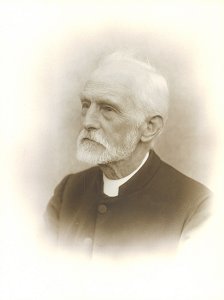 |
The same remarks apply to this 8 inch by 6 inch
portrait photo. It might be thought that in both cases Clark
had captured something of the character of his sitters, despite the
formality of the poses. |
| In later times the Bennett Clark studio was still
there to meet changing needs. This photo has nothing on it to
identify the subjects, but surely they are the Home Guard. |
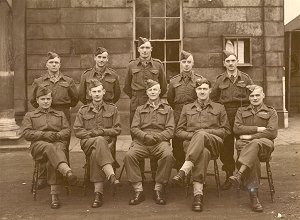 |
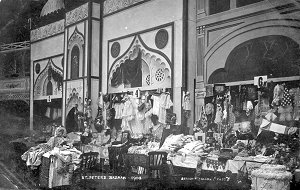 |
Clark was also called on to record "St. Peter's Bazaar 1905"
which, together with "Bennett Clark photo", are the words written
across the bottom of this postcard. |
| A troupe of pierrots called Clark out for this publicity
postcard. Bennett Clark's impressed stamp can be made out in the
bottom right hand corner. |
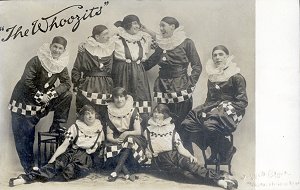 |
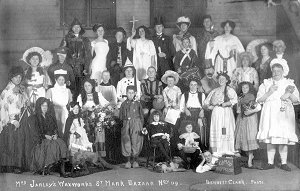 |
In fact nothing was too outlandish for Clark. If you
wanted a photograph, he would provide it. Here are "Mrs Jarley's Waxworks St Marks Bazaar Nov 09", enshrined in a postcard. |
Thanks to Dr. Roger Sabin I now (about a year after first
writing this page) find that the original Mrs. Jarley's waxworks appeared in
Dickens' "Old Curiosity Shop". The name was taken when theatrical groups,
mainly amateur, dressed up and performed as waxworks, with one of them appearing
as Mrs. Jarley, and others appearing as her assistants. The "waxworks"
appeared on stage in groups. Each one was described, in a humorous way, by
Mrs. Jarley and was then "wound up" and "oiled" by the assistants, when they
performed a few jerky, mechanical movements. A script for such a show was
available from Samuel French, but there seems to have been nothing to prevent
amateur troupes, or anyone else, from selecting their own characters and writing
their own accompanying script. Such waxwork shows appear to have been
popular in late Victorian and Edwardian times. I can provide a bigger
version of this photo to anyone wanting to try to identify which characters were
thought worth while representing to Wolverhampton people in 1909.
| Later in date and a world away, this is a Bennett Clark
photo for Turner Brothers of Bilston. The white out behind the
containers was added in the studio to give more prominence to the
equipment. |
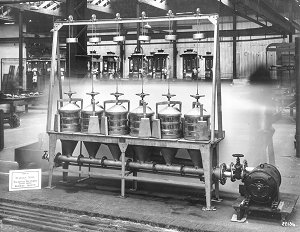 |
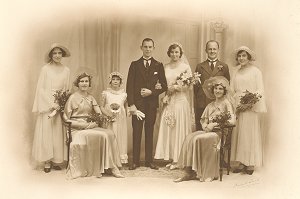 |
Clark also did weddings, but this very high quality photo
seems, from the painted backdrop, to have been taken in his
studio. |
At some point Bennett Clark handed over the studio to
his long time assistant, Hart. Hart at some point married his long
time assistant. Hart carried on the studio until about the
mid 1960s when it closed. All the clients who could be contacted
were asked to come and collect any of their negatives which they wanted.
At least some commercial clients, like the transport executive,
responded. But, of course, many did not and vast amounts of
material were heaved out. (I am indebted to John Hughes for this
information). It seems that throughout his career Bennett
Clark produced postcards and it was probably for this use that he took
most his photographs of Wolverhampton. Some of these topographic
photos are shown on the next pages. |

